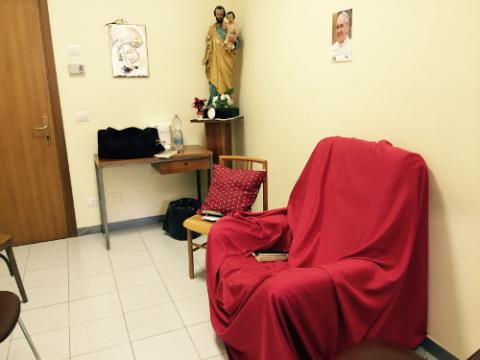
Pauline Fr. Gabriele Amorth (William Friedkin)
Noted film critic Pauline Kael (1919-1991) reviewed William Friedkin's 1973 supernatural thriller "The Exorcist" in the Jan. 7, 1974, edition of The New Yorker, expressing criticism for its lack of emotion as well as a kind of admiration for the film. "The movie may be in the worst imaginable taste — that is, an utterly unfeeling movie about miracles — but it's also the biggest recruiting poster the Catholic Church has had since the sunnier days of 'Going My Way' and 'The Bells of St. Mary's,' " she wrote.
"The Exorcist," based on the 1971 novel of the same name by William Peter Blatty (1926-2017), went through a few directors before Friedkin decided to take it on. The film was highly successful at the box office and won two Academy Awards.
Now Friedkin is back — 45 years later — with a documentary titled "The Devil and Father Amorth" about the ministry of Pauline Fr. Gabriele Amorth, (1925-2016) who served as an exorcist of the Rome diocese for over 30 years. After reviewing the back story and filming of "The Exorcist" film, Friedkin goes on to explore the rite of exorcism. In fact, about 17 minutes of the film are dedicated to the ninth exorcism of Cristina, a 46-year-old single woman and architect from southern Italy. There are also interviews with Nadia, who was successfully liberated of demonic possession by Amorth and her brother, Paolo, who became Amorth's assistant.
The film, made in 2016, was not completed until after Amorth's death at the age of 91 in September of that year. Amorth was unable to complete the exorcism of Cristina, as exorcisms often take many lengthy and intense sessions over weeks, months, even years.
Amorth, born in Modena, Italy, served in the Italian resistance in World War II, became a lawyer and then decided to become a priest. He entered the Society of St. Paul and was ordained in 1954. Interestingly enough, the Society of St. Paul was founded by Blessed James Alberione (1884-1971) who also founded my religious congregation, the Daughters of St. Paul. This connection enabled me to find out some additional information about Amorth as well as to confirm that he was a bit of a "character" who liked to joke, as shown in the film.
Amorth was involved in the religious formation program of the Society of St. Paul and wrote for the then-largest Catholic weekly magazine in the world, La Famiglia Cristiana. His specialty was Marian theology and spirituality and he later became the editor of the society's magazine, La Madre di Dio.
In 1986, he was asked to become an exorcist for the Rome diocese. Members of the Society of St. Paul that I spoke to for this review do not know the connection between the communication and media apostolate of the Society of St. Paul and the ministry of exorcism. Nevertheless, Amorth accepted this role with the blessing of his superiors.

The room where Pauline Fr. Gabriele Amorth performed exorcisms (William Friedkin)
He first carried out exorcisms in a room in an old part of the Lateran Palace that contains "La Scala Santa" or the steps that Jesus walked up to meet Pilate in Jerusalem. According to tradition, the steps were brought to Rome in the fourth century by St. Helena, mother of Constantine.
When the noise created during exorcisms began to disturb pilgrims climbing the holy stairs on their knees, Amorth moved his ministry to the residence of the Society of St. Paul near the Queen of the Apostles (Regina degli Apostoli) in the Ostinese district of Rome. One U.S. Pauline priest told me that while trying to enter the sub-crypt of the basilica where the remains of Alberione are interred, he and a companion accidentally entered the sanctuary on the second level, where Amorth was carrying out an exorcism. It was very loud and they made a hasty retreat once they realized what was going on. In the film, Amorth carries out the exorcism of Cristina in a meeting room of the residence of the Pauline community.
Friedkin shows the exorcism footage to various medical and psychiatric experts in New York, Tel Aviv and Los Angeles. He asks about the symptoms Cristina exhibits and if there are any scientific explanations for her condition. One neurosurgeon shows that a tumor might cause hyper-religiosity in a patient but that this was probably not the case with Cristina. Three of the experts allow that there is something going on with Cristina that they cannot explain. One team of doctors seems satisfied with treating similar symptoms in their patients with medication and therapy.
Perhaps the most interesting interview is between Friedkin and Los Angeles Auxiliary Bishop Robert Barron, known for his media apostolate through Word on Fire Ministries. I can only think that Barron probably regrets giving the interview and wishes he had demanded editorial control. It's a little confusing when he says that the devil is good; I think he means that the devil was created good but chose to reject God and all that is good thus choosing evil, to live in the everlasting loss of God.
When Friedkin asks if Barron would carry out an exorcism, Barron expresses his fear of doing so and states that he is not spiritual enough. An exorcist that I spoke to who saw the film told me that a priest should never fear carrying out an exorcism, with the permission of the ordinary, because of the power of Jesus Christ to overcome evil, a power that a priest has because of his sacramental ordination. The exorcist also said that the greatest qualities of an exorcist are humility and faith, not perfection. What Barron does make clear is that before an exorcism is carried out the person is examined by a team of people, including medical doctors and psychiatrists, in order to rule out natural causes before examining the spiritual.
Amorth rightly says in the film that he can only be sure the person is possessed by the devil once he begins the exorcism and the devil reacts to the invocation of Jesus, Mary, the saints and other elements of the rite of exorcism.
Advertisement
This same exorcist (and another that I communicated with who had only seen the trailer of the film) was disappointed and concerned that Amorth gave Friedkin permission to film the exorcism in the first place.
"I hope that people don't see this film to satisfy their curiosity because then seeing this actual exorcism is exploitative," the exorcist told me. "I hope that audiences who see this film remember that people who are oppressed, obsessed, or possessed by the devil (or think they are) are truly suffering and that the rite of exorcism and the pastoral ministry of the priest is to relieve that suffering." This exorcist said that he believes that Nadia and Paolo's description of their experiences of exorcism are authentic.
Friedkin is respectful of this topic but seems very eager to be the one to show the world an actual exorcism and not the product of someone's imagination. Friedkin says that Amorth was the most spiritual man he had ever met and that knowing him enriched his life.
"We know there is evil and good in the world, and that if there are demons, there must also be angels," concludes Friedkin.
"The Devil and Father Amorth" will be in theaters April 20.
[Sr. Rose Pacatte, a member of the Daughters of St. Paul, is the founding director of the Pauline Center for Media Studies in Los Angeles.]








